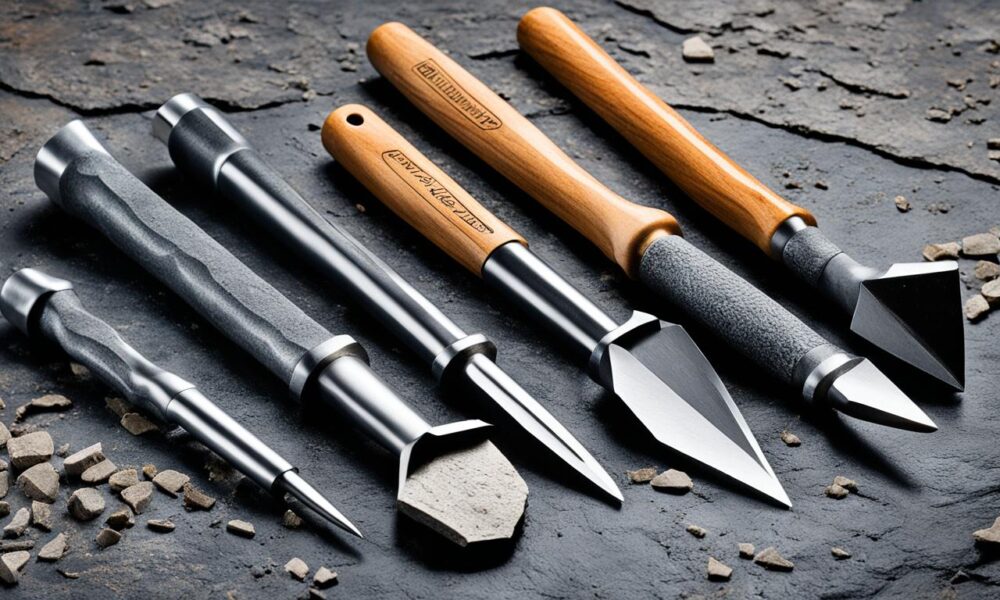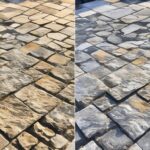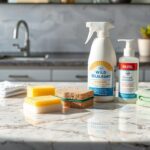Essential Tools for Natural Stone Restoration
Natural stone surfaces like marble, granite, limestone, and slate add elegance and durability to any space. They need proper care to keep their beauty and last long. Restoring natural stone means cleaning, polishing, filling cracks, and sealing. Having the right tools and materials is key for the best results.
Quality tools are vital for stone restoration projects. They give better results and last longer, saving time and money. For cleaning, soft brooms, dust mops, and pH-neutral cleaners are must-haves. These tools remove dirt and debris without scratching the stone.
For tough stains and deeper cleaning, tools like poultice powders, grout brushes, and oxygen-based bleach powders are useful. These products remove stains safely. Diamond abrasive pads, polishing compounds, and honing powders are essential for polishing and honing. They bring back the stone’s shine and smoothness.
Sealing is also crucial for natural stone restoration. A good stone sealant protects against stains, etching, and damage from moisture and acidic substances. Sealing should be done every 1-3 years, depending on the stone type and usage.
Using the right tools and materials, along with proper techniques and experience, is key for successful stone restoration. Investing in quality tools and following best practices ensures natural stone surfaces stay elegant and durable for years.
Key Takeaways
- Natural stone restoration needs the right tools and materials for best results
- Daily cleaning with soft brooms, dust mops, and pH-neutral cleaners is essential
- Specialty tools like poultice powders and grout brushes help remove stubborn stains
- Diamond abrasive pads and polishing compounds restore shine and smoothness
- Regular sealing with high-quality stone sealants protects against staining and damage
- Proper tools and techniques ensure the longevity and beauty of natural stone surfaces
Understanding the Basics of Natural Stone Restoration
Natural stone surfaces like marble, granite, limestone, and travertine are popular for their beauty and durability. They are often used in homes and businesses in Houston. To keep these surfaces looking great, it’s important to know how to care for them. This includes understanding the unique needs of each stone type and how to fix common problems like etching and staining.
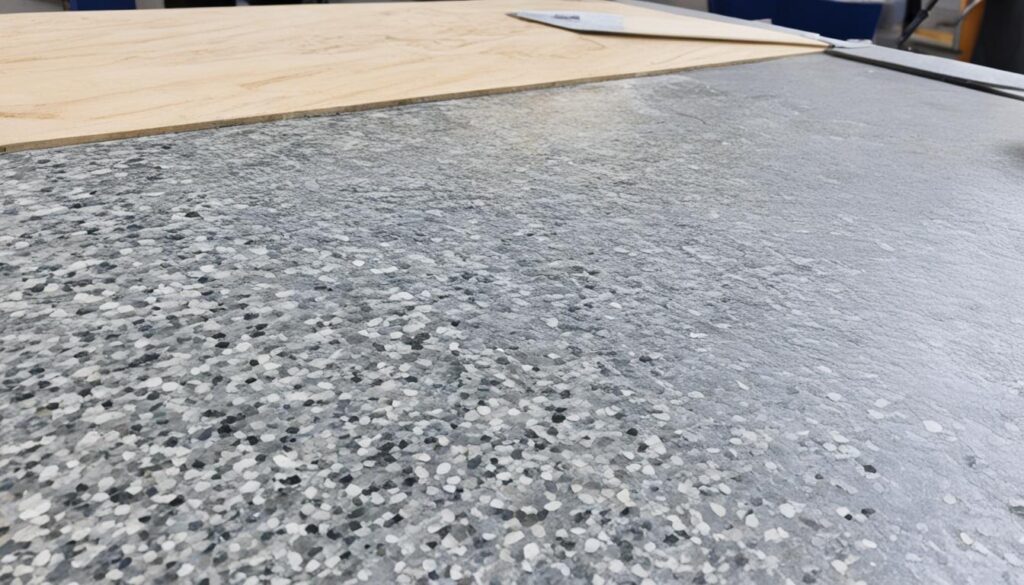
Types of Natural Stone Surfaces
Natural stone comes in three main types: Sedimentary, Metamorphic, and Igneous. Each type can be Calcareous or Siliceous. Calcareous stones, such as marble and limestone, are soft and can be damaged by acidic substances. Siliceous stones, like granite and slate, are harder and more resistant to acid, making them great for busy areas.
Here’s a table that shows the main features of some common natural stones:
| Stone Type | Geological Category | Composition | Characteristics |
|---|---|---|---|
| Marble | Metamorphic | Calcareous | Soft, prone to etching and staining |
| Granite | Igneous | Siliceous | Hard, resistant to acids and staining |
| Limestone | Sedimentary | Calcareous | Soft, sensitive to acids and staining |
| Travertine | Sedimentary | Calcareous | Porous, requires regular sealing |
Common Issues with Natural Stone
Natural stone surfaces can face several problems over time. Some common issues include:
- Etching: Acidic substances like vinegar or lemon juice can cause dull spots on soft stones like limestone and marble.
- Staining: Spills and oils can get into the stone’s pores, causing discoloration and hard-to-remove stains.
- Wear and Tear: High-traffic areas may get scratches, chips, or cracks if not protected with mats or rugs.
To fix these problems, it’s important to use the right cleaning products and methods for each stone type. Avoid harsh cleaners that contain harmful acids. Instead, use gentle cleaners like mild dish soap or stone soap. Sealing your stone surfaces every year or two can also help prevent stains and protect against damage.
By understanding the unique characteristics of natural stone surfaces and using proper care and maintenance, you can keep your marble, granite, limestone, or travertine looking great for many years.
Essential Cleaning Tools for Natural Stone
Keeping your natural stone surfaces clean and long-lasting requires the right tools. With the right equipment, you can remove dirt, debris, and stains safely. Here are some key tools you should have for cleaning your natural stone.
Soft Brooms and Dust Mops
Start by removing loose dirt and debris from your stone surface. Soft brooms and dust mops are perfect for this. They sweep away particles gently without scratching the stone. Choose brooms with soft bristles or dust mops with microfiber or cotton heads for the best results.
pH-Neutral Cleaners
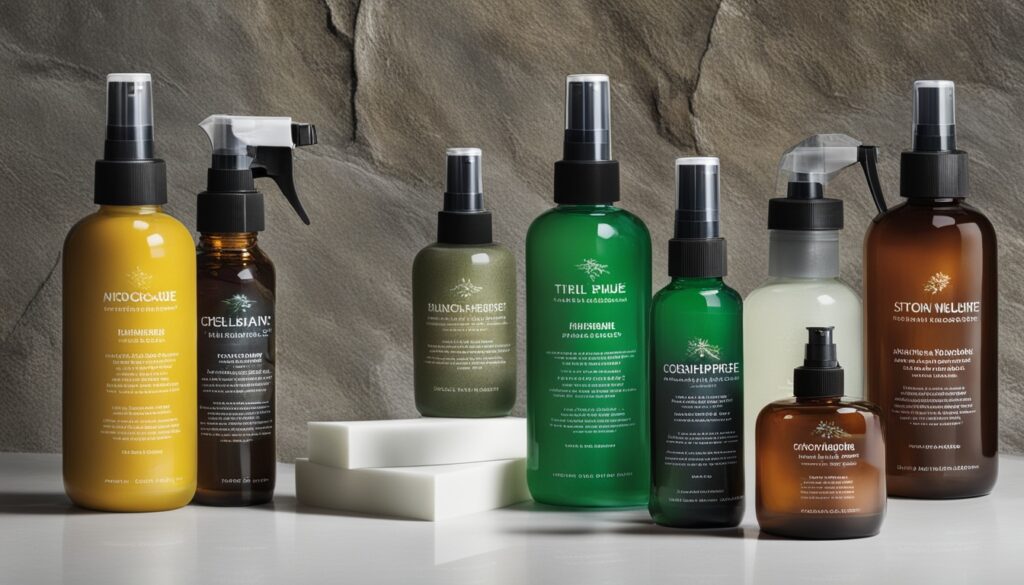
When picking a cleaner for your stone, go for a pH-neutral formula. Avoid harsh, acidic cleaners that can damage the stone. Instead, use mild dish soap or stone cleaning solutions that are gentle yet effective. Always follow the instructions and dilute the cleaner as needed.
Mops and Buckets
A mop and bucket are crucial for cleaning your stone floors regularly. Choose a mop with a soft, absorbent head like microfiber or cotton. Mix warm water with a few drops of your chosen pH-neutral cleaner in the bucket. Make sure to wring out the mop well to avoid soaking the stone, which can cause water damage.
Microfiber Cloths
Microfiber cloths are a must-have for cleaning your stone. They’re soft, lint-free, and perfect for cleaning countertops and other surfaces without scratching them. They also absorb well, making them great for drying surfaces to prevent water spots and streaks. Keep a stack of clean microfiber cloths handy for quick cleaning tasks.
| Cleaning Tool | Purpose | Recommended Features |
|---|---|---|
| Soft Brooms and Dust Mops | Remove loose dirt and debris | Soft, flexible bristles or microfiber/cotton heads |
| pH-Neutral Cleaners | Safely clean without damaging stone | Mild dish soaps or specialized stone cleaners |
| Mops and Buckets | Regular cleaning of stone floors | Soft, absorbent mop heads and sturdy buckets |
| Microfiber Cloths | Wipe surfaces and dry after cleaning | Soft, lint-free, and highly absorbent |
With these essential cleaning tools and the right stone cleaning solutions, you can keep your natural stone looking great for years. Always handle your stone with care and follow the manufacturer’s guidelines to protect your investment.
Specialty Tools for Stain Removal
Removing tough stains from natural stone surfaces requires the right tools. Products like poultice powders, grout brushes, and oxygen-based bleach powders are key. They make cleaning more effective and efficient.
Poultice Powders
Poultice powders are vital for removing hard stains. Mix them with water to make a paste, then apply it to the stain. Leave it for about 24 hours to draw out the stain.
According to Beyond Stone Solutions, their R152 Oil and Wax Remover Paste covers about 2 sq ft per liter. It can go up to 2cm deep, perfect for polished or fine-honed surfaces.
Grout Brushes
Grout brushes are crucial for keeping natural stone looking great. They scrub away dirt and stains from between tiles. Their stiff bristles and ergonomic handles make cleaning easier and more effective.
To remove stains and grout haze, a stone-specific poultice can be utilized.
Oxygen-Based Bleach Powders
Oxygen-based bleach powders are great for tough stains on grout and stone. They release oxygen ions to break down and remove stains. This type of bleach is safer and less harsh than chlorine bleach, making it ideal for natural stone.
| Product | Coverage | Drying Time |
|---|---|---|
| R152 Oil and Wax Remover Paste | 2 sq ft per liter | 10-12 hours |
| R155 Commercial Grade Stone Cleaner | 110-320 sq ft per liter (diluted) | N/A |
Always test specialty tools on a small area first to avoid damage. With the right tools and knowledge, your natural stone can stay beautiful for years.
Polishing and Honing Tools for Natural Stone
Restoring the shine and smoothness of natural stones like marble, granite, and limestone is key. The right tools are vital for this. They help remove scratches, etching, and other flaws, making the stone look beautiful.
Diamond Abrasive Pads
Diamond abrasive pads are a must for polishing natural stone. They come in different grits, from coarse to fine. Used with water, they gradually remove scratches and etching from the stone. This prepares the surface for the final polish.
Stone Polishing Compounds
After smoothing the surface with diamond pads, stone polishing compounds are applied for a high-gloss finish. These compounds are applied with a polishing pad or brush. They highlight the stone’s natural beauty. Various compounds are made for different stones, ensuring the best results.
Honing Powders and Creams
Honing powders and creams are perfect for a smooth, matte finish. They remove minor scratches and imperfections, creating a consistent surface. Often, they are used with diamond abrasive pads to get the right smoothness.
| Tool | Purpose | Key Features |
|---|---|---|
| Diamond Abrasive Pads | Remove scratches and etching | Available in various grits, used with water |
| Stone Polishing Compounds | Achieve high-gloss finish | Applied with polishing pad or brush, stone-specific formulas |
| Honing Powders and Creams | Create smooth, matte finish | Remove minor scratches, create consistent surface |
Using these polishing and honing tools, professionals can bring back the beauty and strength of natural stone surfaces. This ensures they look great for many years.
Sealing and Protecting Natural Stone Surfaces
Sealing natural stone surfaces is key to keeping them beautiful and long-lasting. The Stone and Tile School found that most natural stones are quite porous, making them prone to stains and damage without a seal. The National Center for Preservation Technology and Training (NCPTT) showed that preparing the stone surface well can make sealants work up to 40% better. This highlights the need for a clean surface before applying a stone sealant.
There are two main types of sealants: penetrating and topical. Penetrating sealers, like silicone-based ones, go deep into the stone’s pores for lasting protection without changing how the stone looks. Topical sealers, such as acrylic or polyurethane-based ones, create a protective layer on the stone’s surface. They can give a glossy or matte look. The choice between them depends on the stone type and the look you want.
Importance of Sealing Natural Stone
Sealing natural stone is very important. A 2021 University of Florida study showed that unsealed stone can degrade up to 30% faster than sealed stone due to UV exposure and weather. This shows how crucial proper protection is. Even dense stones like granite benefit from sealing to prevent stains. Regular sealing stops stains, etching, and wear, keeping your stone looking great for years.
Types of Stone Sealants
When picking a stone sealant, think about the stone type and the finish you want. Penetrating sealers are top choices for sealing natural stone because they protect without changing the stone’s look. They work well on porous stones like marble, limestone, and travertine. Topical sealers can make the stone’s color pop and give it a glossy or matte finish. They’re great for countertops and decorative pieces but need to be reapplied more often than penetrating sealers.
Choosing the right sealant is important, but so is applying it correctly. Let the stone dry for 24-72 hours after cleaning before sealing. Apply the sealant in thin, even layers. After it’s almost dry, buff it with a dry microfiber cloth to remove streaks. Wait 72 hours before heavy use or potential staining. By following these steps and resealing regularly, you can keep your natural stone beautiful and protected.

